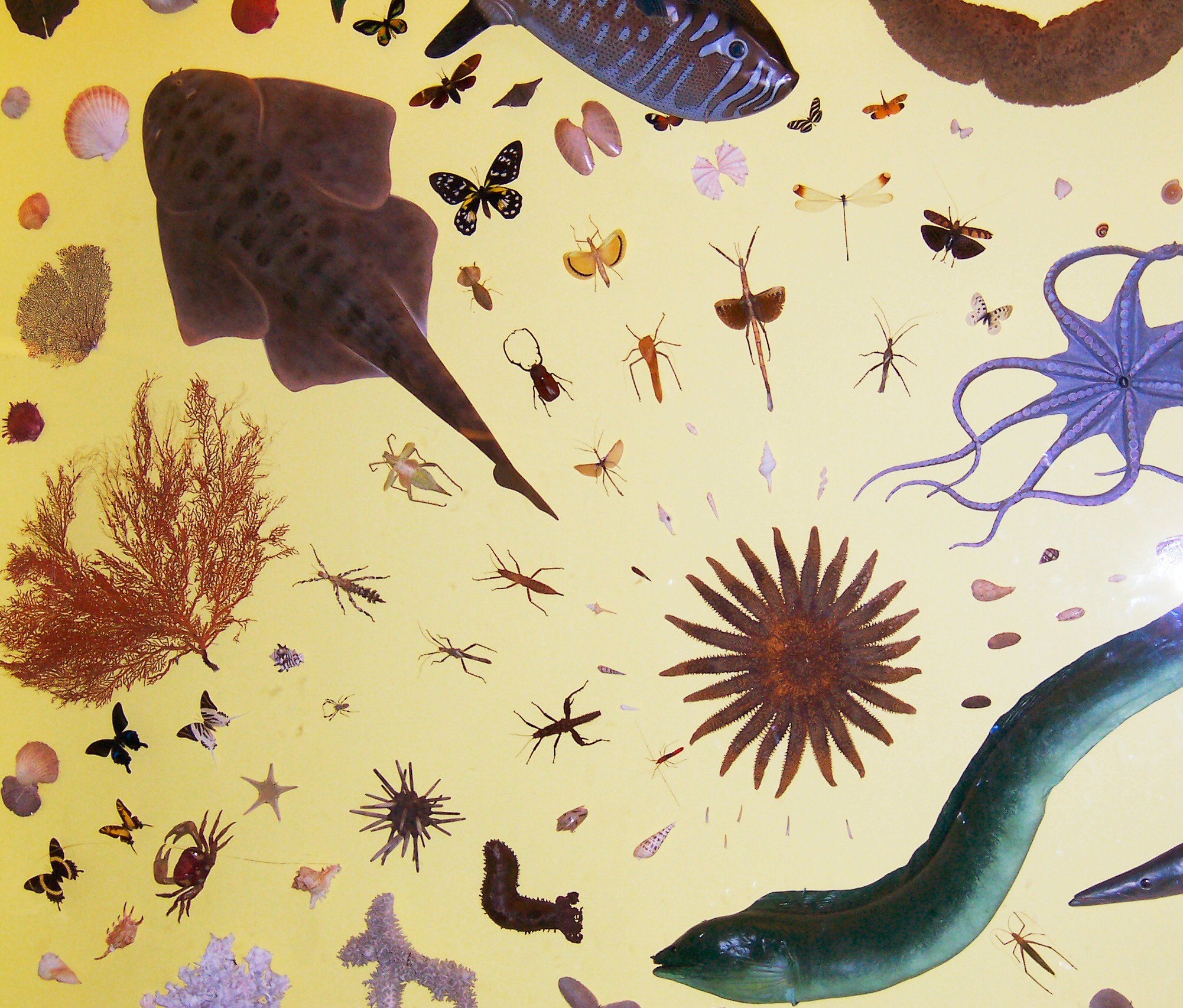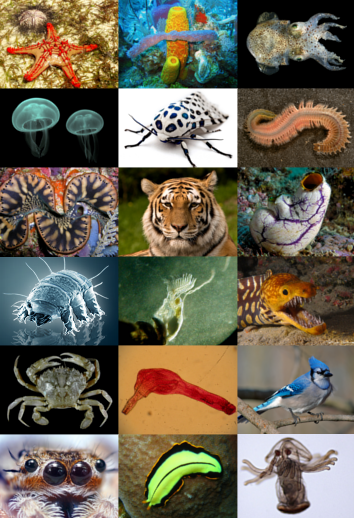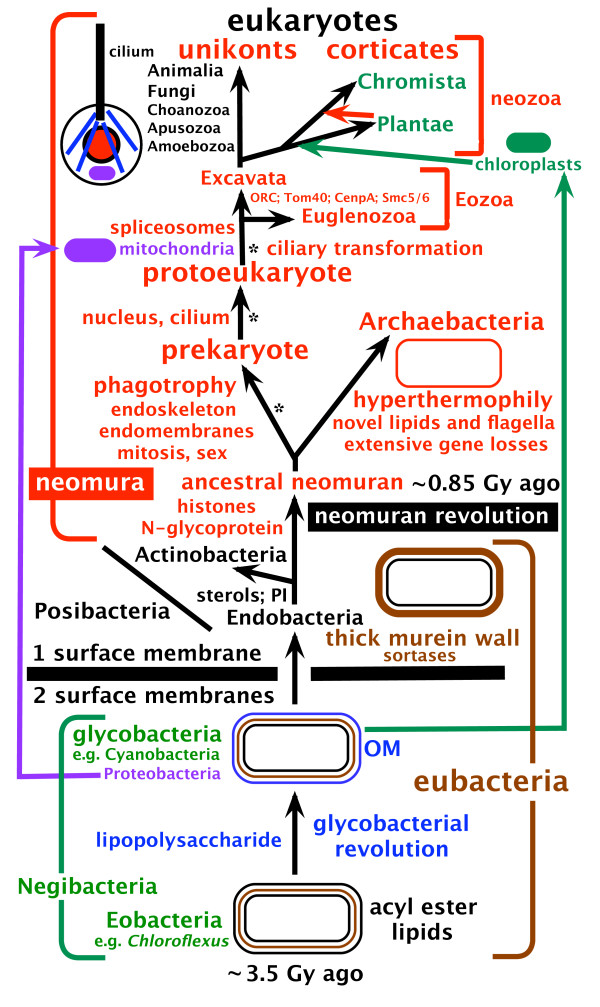|
Radiata
Radiata or Radiates is a historical taxonomic rank that was used to classify animals with Symmetry (biology)#Radial symmetry, radially symmetric body plans. The term Radiata is no longer accepted, as it united several different groupings of animals that do not form a monophyletic group under current views of animal phylogeny. The similarities once offered in justification of the taxon, such as radial symmetry, are now taken to be the result of either incorrect evaluations by early researchers or convergent evolution, rather than an indication of a common ancestor. Because of this, the term is used mostly in a historical context. In the early 19th century, Georges Cuvier united Ctenophora and Cnidaria in the Radiata (''Zoophytes''). Thomas Cavalier-Smith, in 1983, redefined Radiata as a subkingdom consisting of Myxozoa, Placozoa, Cnidaria and Ctenophora. Lynn Margulis and K. V. Schwartz later redefined Radiata in their ''Kingdom (biology)#Five kingdoms, Five Kingdom'' classificati ... [...More Info...] [...Related Items...] OR: [Wikipedia] [Google] [Baidu] |
Radial Symmetry
Symmetry in biology refers to the symmetry observed in organisms, including plants, animals, fungi, and bacteria. External symmetry can be easily seen by just looking at an organism. For example, the face of a human being has a plane of symmetry down its centre, or a pine cone displays a clear symmetrical spiral pattern. Internal features can also show symmetry, for example the tubes in the human body (responsible for transporting gases, nutrients, and waste products) which are cylindrical and have several planes of symmetry. Biological symmetry can be thought of as a balanced distribution of duplicate body parts or shapes within the body of an organism. Importantly, unlike in mathematics, symmetry in biology is always approximate. For example, plant leaves – while considered symmetrical – rarely match up exactly when folded in half. Symmetry is one class of patterns in nature whereby there is near-repetition of the pattern element, either by reflection or rotation. W ... [...More Info...] [...Related Items...] OR: [Wikipedia] [Google] [Baidu] |
Zoophytes
A zoophyte (animal-plant) is an obsolete term for an organism thought to be intermediate between animals and plants, or an animal with plant-like attributes or appearance. In the 19th century they were reclassified as Radiata which included various taxa, a term superseded by Coelenterata referring more narrowly to the animal phylum, phyla Cnidaria (coral animals, true jellies, sea anemones, sea pens, and their allies), sponges, and Ctenophora (comb jellies). A group of strange creatures that exist somewhere on, or between, the boundaries of plants and animals kingdoms were the subject of considerable debate in the eighteenth century. Some naturalists believed that they were a blend of plant and animal; other naturalists considered them to be entirely either plant or animal (such as sea anemones). Ancient and medieval to early modern era In Eastern cultures such as History of China#Ancient China, Ancient China fungi were classified as plants in the Traditional Chinese Medicin ... [...More Info...] [...Related Items...] OR: [Wikipedia] [Google] [Baidu] |
Le Règne Animal
''Le Règne Animal'' () is the most famous work of the French naturalist Georges Cuvier. It sets out to describe the natural structure of the whole of the animal, animal kingdom based on comparative anatomy, and its natural history. Cuvier divided the animals into four ''embranchements'' ("Branches", roughly corresponding to phyla), namely vertebrates, molluscs, articulated animals (arthropods and annelids), and zoophytes (cnidaria and other phyla). The work appeared in four octavo volumes in December 1816 (although it has "1817" on the title pages); a second edition in five volumes was brought out in 1829–1830 and a third, written by twelve "disciples" of Cuvier, in 1836–1849. In this classic work, Cuvier presented the results of his life's research into the structure of living and fossil animals. With the exception of the section on insects, in which he was assisted by his friend Pierre André Latreille, the whole of the work was his own. It was translated into English many ... [...More Info...] [...Related Items...] OR: [Wikipedia] [Google] [Baidu] |
Subkingdom
In biology, a kingdom is the second highest taxonomic rank, just below domain. Kingdoms are divided into smaller groups called phyla (singular phylum). Traditionally, textbooks from Canada and the United States have used a system of six kingdoms (Animalia, Plantae, Fungi, Protista, Archaea/Archaebacteria, and Bacteria or Eubacteria), while textbooks in other parts of the world, such as Bangladesh, Brazil, Greece, India, Pakistan, Spain, and the United Kingdom have used five kingdoms (Animalia, Plantae, Fungi, Protista and Monera). Some recent classifications based on modern cladistics have explicitly abandoned the term ''kingdom'', noting that some traditional kingdoms are not monophyletic, meaning that they do not consist of all the descendants of a common ancestor. The terms ''flora'' (for plants), ''fauna'' (for animals), and, in the 21st century, '' funga'' (for fungi) are also used for life present in a particular region or time. Definition and associated terms When ... [...More Info...] [...Related Items...] OR: [Wikipedia] [Google] [Baidu] |
Kingdom (biology)
In biology, a kingdom is the second highest taxonomic rank, just below domain. Kingdoms are divided into smaller groups called phyla (singular phylum). Traditionally, textbooks from Canada and the United States have used a system of six kingdoms (Animalia, Plantae, Fungi, Protista, Archaea/Archaebacteria, and Bacteria or Eubacteria), while textbooks in other parts of the world, such as Bangladesh, Brazil, Greece, India, Pakistan, Spain, and the United Kingdom have used five kingdoms (Animalia, Plantae, Fungi, Protista and Monera). Some recent classifications based on modern cladistics have explicitly abandoned the term ''kingdom'', noting that some traditional kingdoms are not monophyletic, meaning that they do not consist of all the descendants of a common ancestor. The terms ''flora'' (for plants), ''fauna'' (for animals), and, in the 21st century, '' funga'' (for fungi) are also used for life present in a particular region or time. Definition and associated terms Whe ... [...More Info...] [...Related Items...] OR: [Wikipedia] [Google] [Baidu] |
Body Plan
A body plan, (), or ground plan is a set of morphology (biology), morphological phenotypic trait, features common to many members of a phylum of animals. The vertebrates share one body plan, while invertebrates have many. This term, usually applied to animals, envisages a "blueprint" encompassing aspects such as symmetry (biology), symmetry, Germ layer, layers, segmentation (biology), segmentation, nerve, Limb (anatomy), limb, and Gastrointestinal tract, gut disposition. Evolutionary developmental biology seeks to explain the origins of diverse body plans. Body plans have historically been considered to have evolved in a flash in the Ediacaran biota; filling the Cambrian explosion with the results, and a more nuanced understanding of animal evolution suggests gradual development of body plans throughout the early Palaeozoic. Recent studies in animals and plants started to investigate whether evolutionary constraints on body plan structures can explain the presence of development ... [...More Info...] [...Related Items...] OR: [Wikipedia] [Google] [Baidu] |
Georges Cuvier
Jean Léopold Nicolas Frédéric, baron Cuvier (23 August 1769 – 13 May 1832), known as Georges Cuvier (; ), was a French natural history, naturalist and zoology, zoologist, sometimes referred to as the "founding father of paleontology". Cuvier was a major figure in natural sciences research in the early 19th century and was instrumental in establishing the fields of comparative anatomy and paleontology through his work in comparing living animals with fossils. Cuvier's work is considered the foundation of vertebrate paleontology, and he expanded Linnaean taxonomy by grouping classes into phylum, phyla and incorporating both fossils and living species into the classification. Cuvier is also known for establishing extinction as a fact—at the time, extinction was considered by many of Cuvier's contemporaries to be merely controversial speculation. In his ''Essay on the Theory of the Earth'' (1813) Cuvier proposed that now-extinct species had been wiped out by periodic catastr ... [...More Info...] [...Related Items...] OR: [Wikipedia] [Google] [Baidu] |
Eumetazoa
Eumetazoa (), also known as Epitheliozoa or Histozoa, is a proposed basal animal subkingdom as a sister group of Porifera (sponges). The basal eumetazoan clades are the Ctenophora and the ParaHoxozoa. Placozoa is now also seen as a eumetazoan in the ParaHoxozoa. The competing hypothesis is the Myriazoa clade. The subkingdom Parazoa and Agnotozoa are the other taxa, and agnotozoa may be fake or even nonexistent at studies. Parazoa or Agnotozoa are a main sister group to eumetazoans, forming clade Blastozoa/Diploblastozoa. Alternatively, Parazoa was considered as a sister group to Agnotozoa(now considered polyphyletic). Several other extinct or obscure life forms, such as '' Iotuba'' and '' Thectardis'', appear to have emerged in the group. Characteristics of eumetazoans include true tissues organized into germ layers, the presence of neurons and muscles, and an embryo that goes through a gastrula stage. Some phylogenists once speculated the sponges and eumetazoans evolv ... [...More Info...] [...Related Items...] OR: [Wikipedia] [Google] [Baidu] |
Thomas Cavalier-Smith
Thomas (Tom) Cavalier-Smith, FRS, FRSC, NERC Professorial Fellow (21 October 1942 – 19 March 2021), was a professor of evolutionary biology in the Department of Zoology, at the University of Oxford. His research has led to discovery of a number of unicellular organisms (protists) and advocated for a variety of major taxonomic groups, such as the Chromista, Chromalveolata, Opisthokonta, Rhizaria, and Excavata. He was known for his systems of classification of all organisms. Life and career Cavalier-Smith was born on 21 October 1942 in London. His parents were Mary Maude (née Bratt) and Alan Hailes Spencer Cavalier Smith. He was educated at Norwich School, Gonville and Caius College, Cambridge (MA) in Biology and King's College London (PhD) in Zoology. He was under the supervision of Sir John Randall for his PhD thesis between 1964 and 1967; his thesis was entitled "''Organelle Development in'' Chlamydomonas reinhardii". From 1967 to 1969, Cavalier-S ... [...More Info...] [...Related Items...] OR: [Wikipedia] [Google] [Baidu] |
Coelenterata
Coelenterata is a term encompassing the animal phyla Cnidaria (corals, true jellies, sea anemones, sea pens, and their relatives) and Ctenophora (comb jellies). The name comes , referring to the hollow body cavity common to these two phyla. They have very simple tissue organization, with only two layers of cells (ectoderm and endoderm), along with a middle undifferentiated layer called the mesoglea, and radial symmetry. Coelenterata lack a specialized circulatory system, relying instead on diffusion across the tissue layers. Characteristics All coelenterates are aquatic, mostly marine, animals. The body form is radially symmetrical, diploblastic and does not have a coelom. The body has a single opening, the ', surrounded by sensory tentacles equipped with either nematocysts or colloblasts to capture mostly planktonic prey. These tentacles are surrounded by a spacious cavity called the gastrovascular cavity, or coelenteron. Digestion is both intracellular and extracellul ... [...More Info...] [...Related Items...] OR: [Wikipedia] [Google] [Baidu] |





